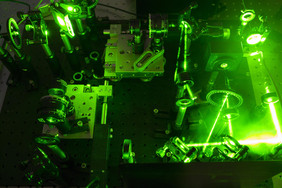Jena Laser Technology Conference brings together top international researchers

Insights into the brain’s hidden depths, observing living cells and detecting diseases such as cancer at an early stage while at the same time combining diagnosis with gentle treatment: Ultrafast lasers open up an enormous potential for medicine and the life sciences. From September 3 to 6, 2019 in Jena, top international researchers will discuss where developments in spectroscopy and imaging with ultrafast laser technology are heading. At the “European Symposium on Ultrafast Laser Driven Biophotonics” – ESULaB 2019 – speakers like Nobel Laureate Stefan Hell or Mihaela Zigman and Ferenc Krausz from the Max Planck Institute for Quantum Optics will present their latest findings.
“With the help of biophotonics, it is possible, for example, to better understand the causes of diseases so that they can be prevented in the future or at least diagnosed earlier and more precisely and thus treated more effectively“, says conference chair Prof. Jürgen Popp, scientific director of the Leibniz Institute of Photonic Technology (Leibniz IPHT) in Jena, which is hosting the conference. Scientists in the relatively new research area of biophotonics are combining life sciences, environmental sciences and medicine with innovative optical technologies.
“In order to advance biophotonic research, we have to further develop optical and spectroscopic methods,” adds Dr. Peter Vogt, Director Field Sales Europe Scientific of Coherent Europe BV. Being one of the world’s leading laser manufacturers Coherent co-organises the conference. “This requires new light sources, optical components and detectors, for example.
Scientists made progress in the development of intensive, ultra-short pulsed laser sources by exploiting new, non-linear optical phenomena and thus promoting developments in biophotonics. Multiphoton microscopy, for example, is now an integral part of modern biomedical research.
At ESULaB 2019, high-ranking scientists from various disciplines in Germany, Europe and the US will present their research. The spectrum of topics includes nonlinear imaging for biomedical diagnostics (e.g. SHG/THG microscopy, coherent Raman microscopy) as well as imaging of biological objects with highest spatial resolution. Stefan Hell, Director of the Max Planck Institute for Biophysical Chemistry in Göttingen, will speak on this topic. With his microscopy method “STED” (Stimulated Emission Depletion), he levered out the resolution limit of optical microscopy and was awarded the Nobel Prize for Chemistry in 2014. Today, he is developing new microscopes with which living cells can be observed live. Further topics of ESULaB 2019 are the ultra-short time spectroscopy of biological systems – such as protein folding dynamics using 2D spectroscopy – and wavelengths in the EUV/X-ray range.
An industrial forum offers researchers and industry representatives the opportunity to exchange ideas. Participation in the conference is free of charge.
Registration at: www.esulab.org
Contact
Related News
Third party cookies & scripts
This site uses cookies. For optimal performance, smooth social media and promotional use, it is recommended that you agree to third party cookies and scripts. This may involve sharing information about your use of the third-party social media, advertising and analytics website.
For more information, see privacy policy and imprint.
Which cookies & scripts and the associated processing of your personal data do you agree with?
You can change your preferences anytime by visiting privacy policy.


